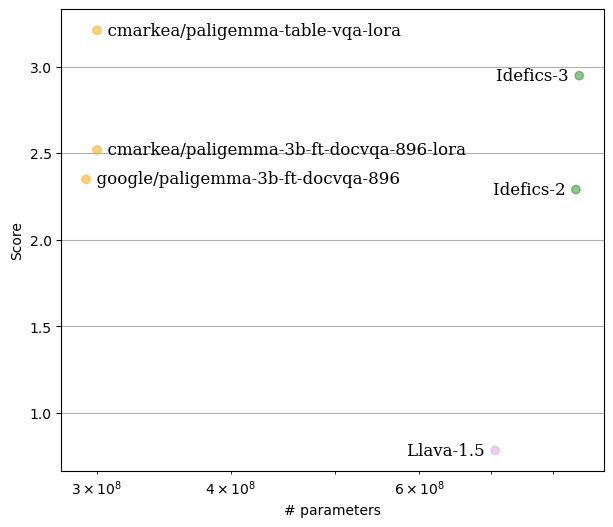|
--- |
|
base_model: google/paligemma-3b-ft-docvqa-896 |
|
library_name: peft |
|
license: apache-2.0 |
|
datasets: |
|
- cmarkea/table-vqa |
|
language: |
|
- fr |
|
- en |
|
pipeline_tag: visual-question-answering |
|
--- |
|
|
|
## Model Description |
|
|
|
**paligemma-3b-ft-tablevqa-896-lora** is a fine-tuned version of the **[google/paligemma-3b-ft-docvqa-896](https://huggingface.co/google/paligemma-3b-ft-docvqa-896)** model, |
|
trained specifically on the **[table-vqa](https://huggingface.co/datasets/cmarkea/table-vqa)** dataset published by Crédit Mutuel Arkéa. This model leverages the |
|
**LoRA** (Low-Rank Adaptation) technique, which significantly reduces the computational complexity of fine-tuning while maintaining high performance. The model operates |
|
in bfloat16 precision for efficiency, making it an ideal solution for resource-constrained environments. |
|
|
|
This model is designed for multilingual environments (French and English) and excels in table-based visual question-answering (VQA) tasks. It is highly suitable for |
|
extracting information from tables in documents, making it a strong candidate for applications in financial reporting, data analysis, or administrative document processing. |
|
The model was fine-tuned over a span of 7 days using a single A100 40GB GPU. |
|
|
|
## Key Features |
|
|
|
- **Language:** Multilingual capabilities, optimized for French and English. |
|
- **Model Type:** Multi-modal (image-text-to-text). |
|
- **Precision:** bfloat16 for resource efficiency. |
|
- **Training Duration:** 7 days on A100 40GB GPU. |
|
- **Fine-Tuning Method:** LoRA (Low-Rank Adaptation). |
|
- **Domain:** Table-based visual question answering. |
|
|
|
## Model Architecture |
|
|
|
This model was built on top of **[google/paligemma-3b-ft-docvqa-896](https://huggingface.co/google/paligemma-3b-ft-docvqa-896)**, using its pre-trained multi-modal |
|
capabilities to process both text and images (e.g., document tables). LoRA was applied to reduce the size and complexity of fine-tuning while preserving accuracy, |
|
allowing the model to excel in specific tasks such as table understanding and VQA. |
|
|
|
## Usage |
|
|
|
You can use this model for visual question answering with table-based data by following the steps below: |
|
|
|
```python |
|
from transformers import AutoProcessor, PaliGemmaForConditionalGeneration |
|
from PIL import Image |
|
import requests |
|
import torch |
|
device = "cuda" if torch.cuda.is_available() else "cpu" |
|
|
|
model_id = "cmarkea/paligemma-3b-ft-tablevqa-896-lora" |
|
|
|
# Sample image for inference |
|
url = "https://datasets-server.huggingface.co/cached-assets/cmarkea/table-vqa/--/c26968da3346f92ab6bfc5fec85592f8250e23f5/--/default/train/22/image/image.jpg?Expires=1728915081&Signature=Zkrd9ZWt5b9XtY0UFrgfrTuqo58DHWIJ00ZwXAymmL-mrwqnWWmiwUPelYOOjPZZdlP7gAvt96M1PKeg9a2TFm7hDrnnRAEO~W89li~AKU2apA81M6AZgwMCxc2A0xBe6rnCPQumiCGD7IsFnFVwcxkgMQXyNEL7bEem6cT0Cief9DkURUDCC-kheQY1hhkiqLLUt3ITs6o2KwPdW97EAQ0~VBK1cERgABKXnzPfAImnvjw7L-5ZXCcMJLrvuxwgOQ~DYPs456ZVxQLbTxuDwlxvNbpSKoqoAQv0CskuQwTFCq2b5MOkCCp9zoqYJxhUhJ-aI3lhyIAjmnsL4bhe6A__&Key-Pair-Id=K3EI6M078Z3AC3" |
|
image = Image.open(requests.get(url, stream=True).raw) |
|
|
|
# Load the fine-tuned model and processor |
|
model = PaliGemmaForConditionalGeneration.from_pretrained( |
|
model_id, |
|
torch_dtype=torch.bfloat16, |
|
device_map=device, |
|
).eval() |
|
|
|
processor = AutoProcessor.from_pretrained("google/paligemma-3b-ft-docvqa-896") |
|
|
|
# Input prompt for table VQA |
|
prompt = "How many rows are in this table?" |
|
model_inputs = processor(text=prompt, images=image, return_tensors="pt").to(model.device) |
|
|
|
# Generate the answer |
|
input_len = model_inputs["input_ids"].shape[-1] |
|
with torch.inference_mode(): |
|
generation = model.generate(**model_inputs, max_new_tokens=100, do_sample=False) |
|
generation = generation[0][input_len:] |
|
decoded = processor.decode(generation, skip_special_tokens=True) |
|
print(decoded) |
|
``` |
|
|
|
|
|
## Performance |
|
|
|
The model's performance was evaluated on 200 question-answer pairs, extracted from 100 tables from the test set of the |
|
**[table-vqa](https://huggingface.co/datasets/cmarkea/table-vqa)** dataset. For each table, two pairs were selected: one in French and the other in English. |
|
|
|
To evaluate the model’s responses, the **[LLM-as-Juries](https://arxiv.org/abs/2404.18796)** framework was employed using three judge models (GPT-4o, Gemini1.5 Pro, |
|
and Claude 3.5-Sonnet). The evaluation was based on a scale from 0 to 5, tailored to the VQA context, ensuring accurate judgment of the model’s performance. |
|
|
|
Here’s a visualization of the results: |
|
|
|
 |
|
|
|
In comparison, this model outperforms **[HuggingFaceM4/Idefics3-8B-Llama3](https://huggingface.co/HuggingFaceM4/Idefics3-8B-Llama3)** in terms of accuracy and efficiency, |
|
despite having a smaller parameter size. |
|
|
|
|
|
## Citation |
|
|
|
```bibtex |
|
@online{AgDePaligemmaTabVQA, |
|
AUTHOR = {Tom Agonnoude, Cyrile Delestre}, |
|
URL = {https://huggingface.co/cmarkea/paligemma-tablevqa-896-lora}, |
|
YEAR = {2024}, |
|
KEYWORDS = {Multimodal, VQA, Table Understanding, LoRA}, |
|
} |